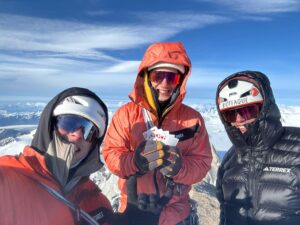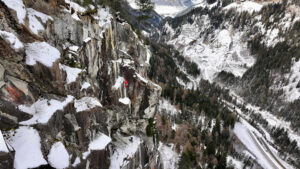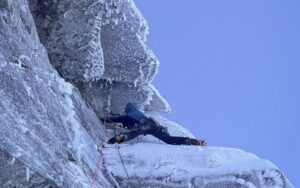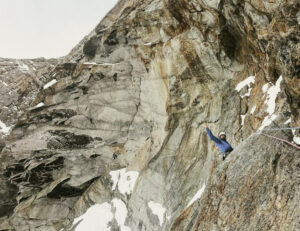From April 19 and April 21, 2022, U.S. climbers Anna Pfaff and Priti Wright climbed the challenging 1,200m Harvard Route on Mount Huntington in Alaska.
However, after the successful ascent, Pfaff has been dealing with extreme frostbite on her feet. Over the last month, her toes have not improved and Pfaff will now face the amputation of five toes this week.

Priti Wright (left) and Anna Pfaff (right) on the summit of 3,731m Mount Huntington, Alaska. Photo: Anna Pfaff
The climb
Wright and Pfaff found the climbing harder than expected. It was early in the season on Mount Huntington, and the pair were the first to summit. The climb and descent took them three days.

Climbing up the Harvard Route on Mount Huntington. Photo: Anna Pfaff
After ascending the Harvard Route, Pfaff and Wright returned to base camp down the West Face Couloir.
“I pulled my boots off as soon as I arrived in the tent and changed out of my socks and clothes. At that time, I noticed my right foot was swollen and whitish,” recalls Pfaff. The whitish color is the first sign of frostbite.

Pfaff in the tent, warming up her feet. Photo: Anna Pfaff
Frostbite
Pfaff, a trauma nurse by profession who has completed several difficult expeditions, knew she had to warm up her feet as soon as possible. She kept her feet in her sleeping bag and felt relief during dinner.

The challenging 1,212m-long Harvard Route. Photo: Anna Pfaff
Pfaff had been wearing an excellent pair of boots. She changed socks at night and hydrated during the climb. Pfaff says that her feet never felt extremely cold, and the two climbers made no obvious mistakes. However, the temperature dropped noticeably during the night as they descended to Base Camp.
They told Talkeetna Air Taxi (TAT), the operator that provides logistical support in the area, that they needed to leave the mountain. However, the weather worsened and there was no visibility for the plane to reach the glacier.
“My heart sank when I realized that another night on the glacier was imminent,” remembers Pfaff. This second night was even colder.

On the Harvard Route. Photo: Anna Pfaff
When the two women checked Pfaff’s feet again in the morning, they were shocked by the state of her frostbitten toes, especially those on her right foot. The plane finally managed to pick them up from the glacier on April 23, and Pfaff was rushed to hospital.
Could anything be done?

In the hyperbaric oxygen treatment cabin. Photo: Anna Pfaff
When a vascular surgeon first examined her in the Anchorage ER, he told her that nothing could be done. She was too late to receive blood-thinning meds.
However, with the help of fellow climbers Priti Wright, Andres Marin, and also Wright’s partner, Jeff Wright, Pfaff was treated in the Harborview of Seattle burn unit. Later, in Louisville, Colorado, she began receiving Hyperbaric Oxygen Treatment (HBOT). The treatment, still classified as experimental in the US, has been shown to help reactivate and improve circulation in similar cases.
Doctors told Pfaff that the mild cold injuries she had sustained through more than 15 years of alpine climbing had likely contributed to what she was dealing with now. Even light frostbite to your extremities might lead to worse consequences during subsequent frostbites.
Pfaff has now received several HBOT sessions, consisting of two hours of treatment twice a day. The temporary side effects are not nice, affecting her hearing and vision. Coping with this process has not been easy. Pfaff describes these weeks as an emotional rollercoaster.

Anna Pfaff in Patagonia. Photo: Camilo Lopez
Necrosis

The frostbitten toes. Photo: Anna Pfaff
At first, Pfaff noticed improvement. However the injury is very serious, and when the necrosis is deep or comprehensive, not much can be done.
A few days ago, Pfaff stated on social media that this week was her “last dance” with her toes. The climbing community has expressed its support and empathy for Pfaff, who is one of the best rock and ice climbers in the world.

Pfaff in Newfoundland, Canada. Photo: Will Mayo Collection






